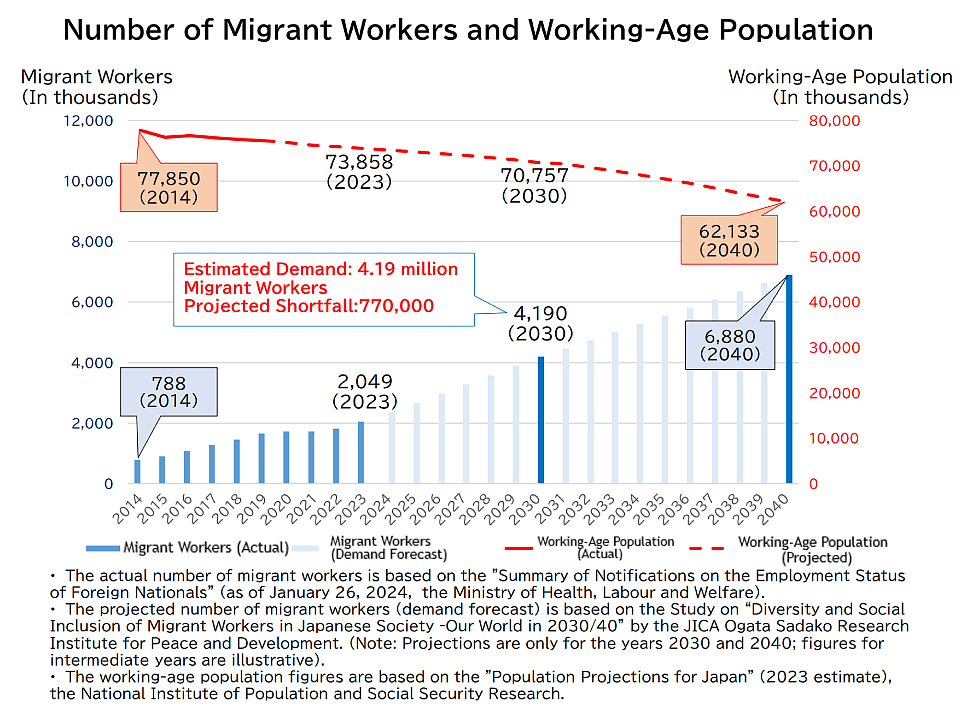Messages from Keidanren Executives and Contributed articles to Keidanren Journals May, 2025 How Migration Helps Japan Meet the Challenges of Today

Across Japan — from factory floors to construction sites, to hospitals and healthcare facilities and restaurants and hotels — migrant workers help keep things moving. The companies and industries need them, and they're a part of the fabric of work just about everywhere in Japan.
More than two million migrant workers are in Japan, filling jobs that might otherwise be vacant. They left their own home country to build a better future for themselves and their loved ones. And in turn, they help to build a better future for all of Japan.
Japan's story is not unique. Across the globe, when there's a safe, well—managed migration system, economies are strengthened, communities — in both countries of origin and destination — are revitalized, and people can grow and prosper.
The challenges of labor worldwide
Japan has a record 2.3 million foreign workers in its labor force. But despite that, Japan and dozens of other large economies in the world have labor shortages. They are especially acute in sectors such as health care and manufacturing.
The consequences of these shortages are real. According to research by the Japan International Cooperation Agency, Japan will need 4.19 million migrant workers in 2030 to sustain economic growth. However, at the current rate of increase in migrant workers, the country will still face a shortfall of 770,000 workers.
Worldwide, labor shortages cost the 30 largest economies an estimated $1.3 trillion in lost GDP yearly, according to a report from Boston Consulting Group, in collaboration with IOM.
Aging populations, a particular problem here in Japan and in many other advanced economies, only exacerbate these labor shortages.
Migration As Part of The Solution
Regular migration pathways are the solution to drawing workers that can help fill these jobs. Yet in many cases, existing pathways are insufficient to meet the full demand, with restrictions on the types of jobs that can be filled or with limited duration and conditions, and limited protection. Too many migrants are working without proper authorization, making them vulnerable to abuse, exploitation, and forced labor.
Addressing the dual challenge of reducing irregular migration while meeting labor demands calls for a tailored, holistic approach that can harness the benefits of migration for countries of origin and destination.
Such an approach would contribute to sustainable development and growth in lower—income countries, while ensuring that wealthier countries with aging populations could continue to sustain their economies.
Strengthening economies through migration
About 170 million people around the world are migrant workers, and those outside the migration field often are unaware how much of an impact they make not just on the place they work, but where they came from.
Migrant workers send USD 905 billion a year back home in what are commonly called remittances. That amount is more than the direct foreign investment to those countries and it's far more than official development assistance.
Additionally, migrants often bring new perspectives, experiences and skillsets that can spur innovation in their home or destination country. For example, according to the Japan External Trade Organization, a Malaysian migrant employee working for a Japanese confectionary wholesaler has been a key driver of the development of food products for Muslims in Japan. The company has already established a factory and a restaurant, which has attracted many migrants in the neighbourhood and attention on social media.
How can the private sector support safe and regular migration—and how IOM can help
IOM, the leading United Nations organization in the field of migration with operations in 171 countries, helps its Member States establish, expand or enhance safe and regular labor pathways that can help the private sector meet workforce demands.
This is a key part of the IOM's wide—ranging mission, which also includes providing life—saving assistance to people on the move and proactive solutions for the increasing levels of displacement brought about by conflict and disasters.
Our role includes working closely with the Japanese private sector to promote corporate responsibility and migrant workers' rights in global supply chains.
IOM offers, in Japanese, a package of free practical resources and guidance materials that can help business enterprises of all sizes if they recruit, manage and employ migrant workers within their business operations and supply chains. Those materials can be accessed here.#1
IOM even provides tailored training and advisory services that helps companies from Japan and elsewhere incorporate the specific rights of migrants into their corporate policies. This training helps the private sector fulfill its responsibility to uphold the rights of migrants, including the right to fair wages and safe working conditions.
For example, IOM helped Fast Retailing assess and improve its suppliers' recruitment processes, address recruitment risks, and build the company's capacity to address migrant worker—related challenges.
The social integration of migrant workers is important not just for the workplace, but for society as a whole. Migrant workers face linguistic, cultural, and social barriers that can hinder their success, and IOM works with the private and public sectors to help address this issue.
For example, IOM and Vietnam's Migrant Health Working Group developed a Health Handbook for Vietnamese workers in Japan, providing practical guidance on navigating Japan's medical system so they can get the help they may need.
With the right systems in place, migration benefits everyone—migrants, their countries of origin, and their host countries. At IOM, we continue working to create opportunities for millions of people on the move—individuals with skills and talents, ready to contribute but lacking an opportunity.
For companies in destination countries to attract migrant workers, they must anticipate future labor market gaps—those that neither the domestic workforce nor AI can fill—and adapt immigration policies accordingly.
South Korea, for example, has positioned itself as a technology hub, making it an attractive destination for global talent. This has drawn more skilled workers and entrepreneurs from countries like India and the United States, often working in IT, science, and corporate sectors.
Italy offers a promising example: in 2023, the country adjusted its immigration policies to welcome more than 450,000 new workers in sectors such as agriculture, health care, and caregiving, in exchange for agreements with origin countries on the return of those residing without legal status.
Safe, orderly, and regular migration has the power to transform lives, economies, and societies. By working together, we can fully harness the promise of migration and make it work for countries of origin, countries of destination — like Japan — and, equally, the migrants themselves.
Amy Pope is the Director General of the International Organization for Migration


